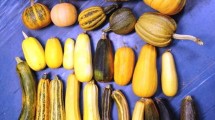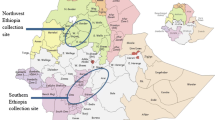Summary
An isoenzyme survey was conducted for several geographically dispersed accessions of four diploid Lotus species, L. alpinus Schleich., L. japonicus (Regel) Larsen, L. tenuis Waldst. et Kit and L. uliginosus Schkuhr, and for the tetraploid L. corniculatus L., in order to ascertain whether isoenzyme data could offer additional evidence concerning the origin of L. corniculatus. Seven enzyme systems were examined using horizontal starch gel electrophoresis. These were PGI, TPI, MDH, IDH, PGM, 6-PGDH, and ME. Lotus uliginosus had monomorphic unique alleles, that were not found within L. corniculatus, at 7 loci. These loci and alleles are: Tpi1-112, Pgm1,2-110, Pgm3-82, Mdh3-68, 6-Pgdh1-110, 6-Pgdh2-98,95, and Me2-100. Other diploid taxa contained alleles found in L. corniculatus for these and other loci. The implications of the isoenzyme data to theories on the origin of L. corniculatus are discussed.
Similar content being viewed by others
References
Brown AHD, Weir BS (1983) Measuring genetic variability in plant populations. In: Tanksley SD; Orton TJ (eds) Isozymes in plant genetics and breeding, part A. Elsevier, Amsterdam New York, pp 219–239
Crawford DJ (1985) Electrophoretic data and plant speciation. Syst Bot 10:405–416
Crompton CW (1982) Pollen morphology of the tribe Loteae (Leguminosae) by light and scanning electron microscopy. M.Sc. Thesis, McGill University, Montreal, Canada
Dawson CDR (1941) Tetrasomic inheritance in Lotus corniculatus L. J Genet 42:49–72
De Lautour G, Jones WT, Ross MD (1978) Production of interspecific hybrids in Lotus aided by endosperm transplants. N Z J Bot 16:61–68
Gottlieb LD (1977) Electrophoretic evidence and plant systematics. Ann Mo Bot Gard 64:161–180
Grant WF (ed) (1984) Plant biosystematics. Academic Press, Toronto New York
Grant WF (1986) The cytogenetics of Lotus (Leguminosae). J Nat Hist 20:1461–1465
Grant WF (1987) Genome differentiation in higher plants. In: Urbanska KM (ed) Differentiation patterns in higher plants. Academic Press, London New York, pp 9–32
Grant WF, Sidhu BS (1967) Basic chromosome number, cyanogenetic glucoside variation, and geographic distribution of Lotus species. Can J Bot 45:639–647
Harney PM, Grant WF (1965) A polygonal presentation of chromatographic investigations on the phenolic content of certain species of Lotus. Can J Genet Cytol 7:40–51
Larsen K (1954) Cytotaxonomical studies in Lotus. I. Lotus corniculatus L. sens. lat. Bot Tidsskr 51:205–211
Larsen K, Zertova A (1965) The Australian Lotus species. Feddes Repert Z Bot Taxon Geobot 72:1–18
Moran PAP (1968) An introduction to probability theory. Clarendon Press, Oxford
Murdy WH, Carter MEB (1985) Electrophoretic study of the allopolyploidal origin of Talinum teretifolium and the specific status of T. appalachianum (Portulacaceae). Am J Bot 72:1590–1597
Nakai Y (1981) D genome donors for Aegilops cylindrica (CCDD) and Triticum aestivum (AABBDD) deduced from esterase isozyme analysis. Theor Appl Genet 60:11–16
Nei M (1972) Genetic distance between populations. Am Nat 106:283–292
Raelson JV, Grant WF (1988) An isoenzyme study in the genus Lotus (Fabaceae). I. Establishment of experimental protocols and genetic basis of electrophoretic phenotype. Genome 30 (in print)
Raelson JV, Lemaître PC, Starkie KM, Grant WF (1988) An isoenzyme study in the genus Lotus (Fabaceae). II. Segregation of isoenzyme alleles in synthetic allo and autotetraploids, and in L. corniculatus. Genome 30 (in print)
Roose ML, Gottlieb LD (1976) Genetic and biochemical consequences of polyploidy in Tragopogon. Evolution 30:818–830
Ross MD, Jones WT (1985) The origin of Lotus corniculatus. Theor Appl Genet 71:284–288
Snedecor GW, Cochran WG (1980) Statistical Methods, 7th edn. Iowa State College Press, Ames/IA
Somaroo BH, Grant WF (1971a) Interspecific hybridization between diploid species of Lotus (Leguminosae). Genetica 42:353–367
Somaroo BH, Grant WF (1971b) Meiotic chromosome behavior in induced autotetraploids and amphidiploids in the Lotus corniculatus group. Can J Genet Cytol 13:663–671
Samaroo BH, Grant WF (1972) Crossing relationships between synthetic Lotus amphidiploids and L. corniculatus. Crop Sci 12:103–105
Stebbins GL (1950) Variation and evolution in plants. Columbia University Press, New York London
Warwick SI, Gottlieb LD (1985) Genetic divergence and geographic speciation in Layia (Compositae). Evolution 39:1236–1241
Wolf PG, Haufler CH, Shefield E (1987) Electrophoretic evidence for genetic diploidy in the bracken fern (Pteridium aqulinum). Science 236:947–949
Author information
Authors and Affiliations
Additional information
Communicated by H. F. Linskens
Rights and permissions
About this article
Cite this article
Raelson, J.V., Grant, W.F. Evaluation of hypotheses concerning the origin of Lotus corniculatus (Fabaceae) using isoenzyme data. Theoret. Appl. Genetics 76, 267–276 (1988). https://doi.org/10.1007/BF00257855
Received:
Accepted:
Issue Date:
DOI: https://doi.org/10.1007/BF00257855




